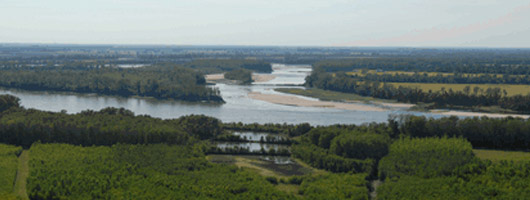
Thompson Bend
From River Mile (R.M.) 7.0 above the confluence with the Ohio River at Cairo, to R.M. 24.0, the Mississippi River flows in a broad sweeping reverse curve. The distance is about 17 river miles; the average gradient is about ½ foot per mile. The narrowest distance across the neck of the large meander loop, an agriculturally rich 10,000-acre land mass known as Dry Bayou-Thompson Bend, is just 1 ¼ miles. Given the close proximity of the confluence of the two rivers, flooding across this area is incredibly erratic. The River can run virtually backward - a high Ohio River backing up a low Mississippi. Or it can be viciously swift - a high Mississippi rushing to a low Ohio. The Great Flood of 1993 presented the worst example of the latter scenario. With a 14-16 foot gradient across the narrow neck of alluvial floodplain, massive erosion and scour could potentially destroy thousands of acres of valuable farmland, create a disastrous Bendway Cutoff, and erode a section of the Commerce/Birds Point Mainline Federal Mississippi Rivers and Tributaries (MR&T) Levee.
The potential results: Farmland destroyed. River navigation transport above Cairo effectively stopped for decades by the new, shorter, steep, high velocity channel and resultant channel changes upstream and downstream. An eroded Mainline Federal Levee flooding some 5,700 square miles of land, all the way to Helena, Arkansas, rendering over 300,000 people homeless.
Both local interests and the Corps had recognized the potential for disaster years earlier and in the 1980's had initiated means to employ both traditional and innovative measures to limit erosion and scour and prevent the triple catastrophe. It was immediately clear the traditional method of using rip-rap to stabilize the bank, was both incredibly expensive and inadequate. Therefore the Corps and an organization of local landowners developed a plan using Nature's own way of minimizing scour and erosion: they designed successive lines of vegetative screens perpendicular to the flow-line across the neck of the Bendway. In January 1986, plantings were initiated of different species of trees and shrubs that eventually totaled over 125 acres, all of it on private land and accomplished with private funds with technical assistance provided by the Corps. Such a plan had never been tried before, but both groups believed it would work. The theory was flood velocities would decrease at each successive tree line, thus limiting scour and erosion and encouraging deposition.
The Great Flood of 1993 provided the ultimate test, and it destroyed much of the project. Trees 60-70 feet tall were bent over and completely submerged for months. And though they died they remained rooted in place, preventing erosion. Though there was scour and erosion across the Bendway, the estimate following the Flood was more net gain of soil due to deposition than loss due to scour. Precise measurement of flows showed velocities cut almost exactly in half by each successive screen. The theory worked very well.
The Project, though, was too limited in scope and too expensive for private interests to restore; it was clear that in the best interest of the Federal Government had to become more involved. Again, Corps personnel and locals together developed a plan: the Thompson Bend Riparian Corridor Project was officially formulated. The Corps is purchasing perpetual easements from landowners to restore and enhance the destroyed tree screens. It is responsible for both planting and initial maintenance of the trees. Landowners retain timber rights but may only selectively harvest with the Corps permission, so as to maintain the integrity of the screens. The landowners still maintain trespass rights. The Corps actively maintains the easements by spraying, mowing between trees, and re-planting. To date, about 90% of the required easements have been purchased. One landowner remains reluctant to participate.
Unfortunately this landowner is positioned right in the middle of the project and remains the weak link in the chain. Easements have been acquired upstream and downstream, and efforts will continue to persuade this landowner to participate.
The Thompson Bend Riparian Corridor Project stretches for 14 miles along the River. The Corridor will be a minimum of 300 feet wide, but will extend up to one mile in critical areas. Costs will be much less than those which would occur if a channel cut-off developed.
The methodology and magnitude of the Thompson Bend Riparian Corridor Project represents a revolutionary and unprecedented blending of various sciences and technologies. The result is a Project expected to be effective for the long term, a Project that is cost-effective, environmentally proactive, friendly, and unique, and mission essential.
Contact Jerry Rapp, P.E. at Robert.j.rapp@usace.army.mil or 314.331.8371 for more information and photos.
